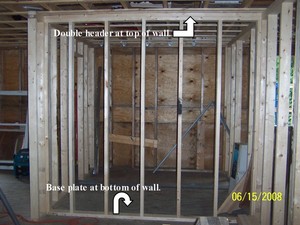So you’ve decided to build that shed out back, or maybe a play house for your kids, or maybe you’re even building on a room addition. You have to build walls to do that, but how do you start? This DIY article on laying out walls will get you going in the right direction.
Start out by selecting the right sill plates. Pressure treated lumber, is the requirement for all walls built on a concrete slab. They have a few different varieties of pressure treated lumber available on the market now, but most people use copper chromium. There are concerns among some as to using this particular chemical, especially in playground equipment, but if the walls are covered on both sides then there shouldn’t be any concern. Endurz is a brand that is used for interior walls that has no arsenic or chromium in it, but is only for interior walls. Borax makes a pressure treated lumber called Tim-bor, that is probably the most environmentally friendly, but its price is much higher than regular pressure treated materials. If you’re not putting the walls on concrete, and placing it on plywood, then regular spruce is fine.
Cut your sill plates to the length of your floor length. Overlap one corner of your sill plate on one side, and recess the other side of your sill plate on the other, so as to sandwich each wall into the other. Just think of a card house, with each card pressing into the other to make it stand up.
Put your two sill plates together and stand them on the long edge (with the 1 ½ inch side facing up). Pull your tape out, and pull from left to right. A common misconception is to lay out your entire wall on 16 inch centers. That will throw off your layout for plywood or sheetrock inside. You should subtract ¾ inches from your 16 inch centers (15 ¼, 31 ¼, 47 ¼, etc.) Now your plywood or sheet rock will start on the outside edge of the 2×4 and end up in the center on the other end.
Don’t forget the windows and doors! Door rough openings are 2 inches bigger than the door. For instance, if your door is 2′-8″ then your opening should be 2′-10″. Most doors are built with two pre-cut studs on each end, called kings, and two cut studs, called jacks. They are nailed together and a header is placed in between them. Jacks typically are cut to 83 inches, with a 2×12 or 2×10 for a header on exterior walls, and a 2×4 for interior walls. If your opening is larger than 4′, then you need to add two jacks and two kings.
When you order windows and doors, make sure you do that before you start to frame the walls! The window and door manufacturer will supply you with rough opening sizes for framing. Most windows typically have a ½ inch gap around them between the framing and are shimmed out so insulation can be added in between them, and contraction and expansion can occur.
After you lay out your plates and build your jacks and headers, frame the wall on the ground. Use two studs with blocks in between them for your outside corners. Lift the walls into place, and brace them off. Level the corners and put a string line on the top and bottom plates to check for bowing. After it’s all leveled and braced off, you’re ready for top plates. Cut the plate so each corner overlaps the other wall. It creates a secure bond between the walls and prevents the walls from separation.
That’s it! You’re ready for plywood exterior and a roof! With some hard work and these simple tips, you’ll be a pro framer in no time!





